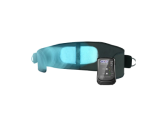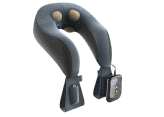What is a Back Spasm? What does a Back Spasm feel like?
Back spasms feel like a sudden, tense contraction or like an involuntary twitch in the back muscles. You may experience intermittent cramping with mild discomfort, or even severe pain that makes mobility and daily life difficult. This pain can also accompany already existing back pain anywhere in the back area.
What causes Back Spasms?
A variety of conditions may be related to back spasms. Some of the causes of back spasms include:
-
Acute injury in the muscles, tendons, ligaments, or other soft tissues surrounding the back area.
-
Repeat or sudden movements and/or heavy lifting.
-
Improper lifting techniques which can strain the back and thoracic area.
-
Disease that affects the spinal discs or nerves in the back.
-
Spinal conditions such as herniated discs or spinal stenosis.
-
Ankylosing spondylitis, which can cause inflammation and stress on the back muscles.
-
Kidney stones, which may lead to muscle pain or inflammation in the back region.
Back spasms can also be related to an underlying anatomical problem or underlying anatomical issue, such as herniated discs or spinal stenosis, especially if spasms persist or worsen. Extra stress on the back, whether from physical overexertion, poor posture, or emotional sources, can contribute to spasms and aggravate muscle tightness or pain. Injuries to soft tissues and ligaments and tendons can also lead to back spasms. Overuse or weakness in other muscles may also play a role in the development or persistence of spasms.
Chronic low back pain is often associated with recurring muscle spasms, and low back pain is a common symptom of these underlying issues.
The source of your pain may be difficult to pinpoint on your own, so it’s recommended to see your preferred healthcare provider for assessment and diagnosis.
Why do I get Back Spasms?
Many factors can make one more prone to experiencing back spasms and back pain in general. Some of these risk factors are:
-
Age: Back pain is more common in those aged 30+.
-
Deconditioned muscles in the back and abdomen from a lack of physical activity, including weak abdominal muscles and lack of strength in the back and abdominal muscles.
-
Poor conditioning of the upper body can also increase risk.
-
Obesity: Excess weight puts added stress on the spine and back.
-
Nerve damage in the back area, often due to injury.
-
Smoking, stress and mental health conditions.
Staying physically active helps maintain muscle health and reduces the risk of back spasms. Proper hydration and good nutrition play a role in preventing muscle spasms by supporting healthy muscle function.
What are the symptoms of a Back Spasm?
Back spasms can present with a wide range of symptoms, and the intensity can vary from person to person. Often, a back spasm is felt as a sudden, severe pain in the back muscles that can make it difficult to move, bend, or even sit comfortably. Some people experience a mild twitch or tightness, while others may feel a sharp, stabbing pain that radiates to other areas, such as the hips or legs. In more severe cases, the pain can be so intense that it disrupts daily activities and makes even simple movements challenging.
Along with pain, back spasms may be accompanied by muscle weakness, odd sensations like numbness or tingling, and difficulty bending or standing upright. These symptoms can occur in any part of the back—upper, middle, or lower—and are often triggered by muscle strain, poor posture, heavy lifting, or underlying anatomical issues like spinal stenosis or a herniated disc. Sometimes, a back spasm may signal a more serious soft tissue injury or even a problem with the spinal cord, especially if the pain is persistent or worsening.
Treatment for back spasms may include physical therapy, muscle relaxants, or other interventions to address the underlying cause and prevent future spasms. In addition to medical care, you can help manage symptoms at home by applying cold therapy or heat to the affected area, practicing gentle stretching and strengthening exercises, staying properly hydrated, and taking steps to reduce stress. By working with your healthcare provider and adopting healthy habits, you can support your back muscles, reduce the risk of future spasms, and get back to your normal activities with less pain.
How can I find Back Spasm relief?
Now that you know more about back spasms, the next step towards feeling better is finding practical and effective ways to manage your pain. Anti inflammatory medication and ice packs are commonly used in back spasm treatment to reduce pain and inflammation. If your pain gets worse or does not improve with at-home spasm treatment, it may be necessary to seek professional back spasm treatment to address the underlying cause and prevent future episodes.
And while prescription medication, surgeries and procedures are often thought of as first choices for treating pain, you may be looking for an alternative method of pain relief for a variety of reasons.
Luckily, there’s a wide range of more natural, non-invasive ways to manage your own back pain and spasms, and this can be done from the comfort of your own home. Take a look at our recommendations for alternative methods of pain relief with an open mind, and find meaningful ways to manage back spasms!
3 Ways to find Back Spasm Relief
1. Hot & Cold Therapies for Back Spasms
Cold and hot therapies Learn more about both to personalize your pain management routine to your specific needs. You can also use both therapies interchangeably in the same routine.
Cold: Apply something cold to the affected area in the form of a cream, pad or ice pack (or ice packs) to target the swelling, inflammation and sharp pain that can come from acute injury or new on-set pain (including spasms). Cold therapy works by reducing blood flow to the area and reducing nerve activity, helping to numb the sensations of pain.
Keep in mind…
-
You should never apply something frozen directly onto the skin.
-
Apply cold therapy for no more than 20 minutes at a time before taking a break to avoid skin, tissue and nerve damage.
Heat: Apply something warm to the affected area in the form of a cream, hot towel or heating pad, or visit a sauna or hot tub to manage your pain with heat therapy. Heat therapy targets soreness, stiffness, and stress, too! Conversely to cold therapy, a heat application can improve local circulation, promote tissue healing and improve muscle flexibility. Those dealing with back spasms may find that heat can help relax their tense muscles.
Keep in mind…
-
Heat therapy is not ideal for the treatment of swelling.
-
Burns can happen easily; test the temperature carefully before widespread application.
Minor back spasms often resolve within a few weeks when managed with therapies like ice packs and heat.
2. TENS Therapy for Back Spasms
TENS therapy (transcutaneous electrical nerve stimulation) is delivered via a TENS device that conducts safe, gentle electrical stimulation through conductive, adhesive pads to pain-affected areas. A TENS device works to deliver these signals to the nervous system so that pain signals sent out by damaged nerves become drowned out and do not register in the brain.
TENS devices are also powered by EMS (electrical muscle stimulation) so that both the nervous system and pain-affected muscle tissues are targeted with gentle, yet powerful stimulation. EMS works in a TENS device to soothe sore, aching muscles and improve local circulation through repetitive expansion and contraction. Because TENS and EMS work together to target a wide variety of pain, a TENS device can be an effective, meaningful choice for temporarily relieving pain associated with muscle spasms.
When muscle spasms and pain strike, it's important to have a device on hand that you can rely on for fast-acting, temporary relief — especially considering how intrusive and unexpected a flare-up of pain can be. While TENS can't address the underlying condition causing muscle spasms, it can help individuals suffering from back spasms get back to some of their normal activities, and feel more like themselves.
Find more information on TENS and product recommendations for back spasm relief:
-
Learn more about how a TENS machine works behind-the-scenes to temporarily relieve pain
-
Find out how to place body pads from your DR-HO'S device to target back spasms
3. Stretching and Yoga for Back Spasms
When you’re in pain, physical activity might be the last thing you want to do. As intimidating as it may be, continuing to move is important to avoid prolonged stiffness and to promote general physical health and wellbeing.
Consulting a physical therapist can help ensure that your stretching and movement routines are safe and effective for your specific needs.
To make it easier to get on your feet and move around, we’ve broken up some physical activities into small steps you can take to incorporate more movement into your routine. By starting with light movement and slowly increasing the intensity, you may be able to prevent injury and strain and work towards strengthening the back muscles in order to prevent future back spasms. Severe back spasms can sometimes make it uncomfortable to have a bowel movement, so gentle movement may also help ease this discomfort.
Step 1 - Gentle Movement: Getting back into physical activity after pain strikes should start with gentle movements including walking and light stretching. Avoid any twisting, bending or sudden movements when in pain.
Step 2 - Yoga for Back Spasms: Once you’re comfortable with gentle movement, try yoga poses that specifically target the back area.
-
Cat-cow pose: While on all fours, take a deep breath and arch your back, extending your head up and back. On the inhale, round out your spine and point your head downwards. Repeat to stretch the spine.
-
Child’s pose: From a kneeling position, reach your hands upwards and begin to fold your torso forward until your palms are flat on the ground and your chest reaches your knees. Pull your arms forward to feel the stretch.
-
Downward dog: From all fours with your hands below your shoulders and knees below your hips, press firmly into the ground, tuck the toes and pull the knees and pelvis upwards and back, towards the ceiling. Straighten your legs and lean into the back stretch.
Step 3 - Use tools to enhance your stretch: When you’re ready to target the back area with more intense pressure, try using a foam roller or acupressure mat to achieve a deep, relieving stretch. Simply lay over an acupressure mat that’s situated on the floor or roll over your most pain-affected areas with a foam roller or ball that digs into the tissues.
Manage Back Spasm Pain on your own terms
We hope that you come away from this with valuable information that helps you create a pain management routine that you feel confident in. Find what works best for you and start feeling more like yourself again!
Learn More about Back Pain on the DR-HO'S Blog!
The Triple Action Back Belt Product Guide
3 Ways DR-HO'S Triple Action Back Belt Helps Relieve Back Pain at Home
The Decompression Belt Product Guide
How DR-HO'S Triple Action Back Belt Outperforms Other Back Support Belts
Mckenzie Back Exercises: A Video Breakdown for Back Pain Sufferers
Poor Posture & Back Pain: X Ways to Find Lower Back Support & Pain Relief
5 Lower Back Pain Relief Stretches & Simple Yoga Moves
Back Decompression Therapy: What is It | How it Works | Can it Help Back Pain
Muscle Spasms in the Lower Back: Know the Causes & How to Find Relief
Disclaimer: This content is for informational purposes, and should not be treated as medical advice. While our advanced TENS machine can benefit various pain conditions through its sophisticated combination of TENS, EMS, and NMES guided by our proprietary AMP Technology, proper diagnosis ensures optimal pad placement and treatment protocols. Always consult a healthcare professional for an accurate diagnosis before beginning any treatment program.







